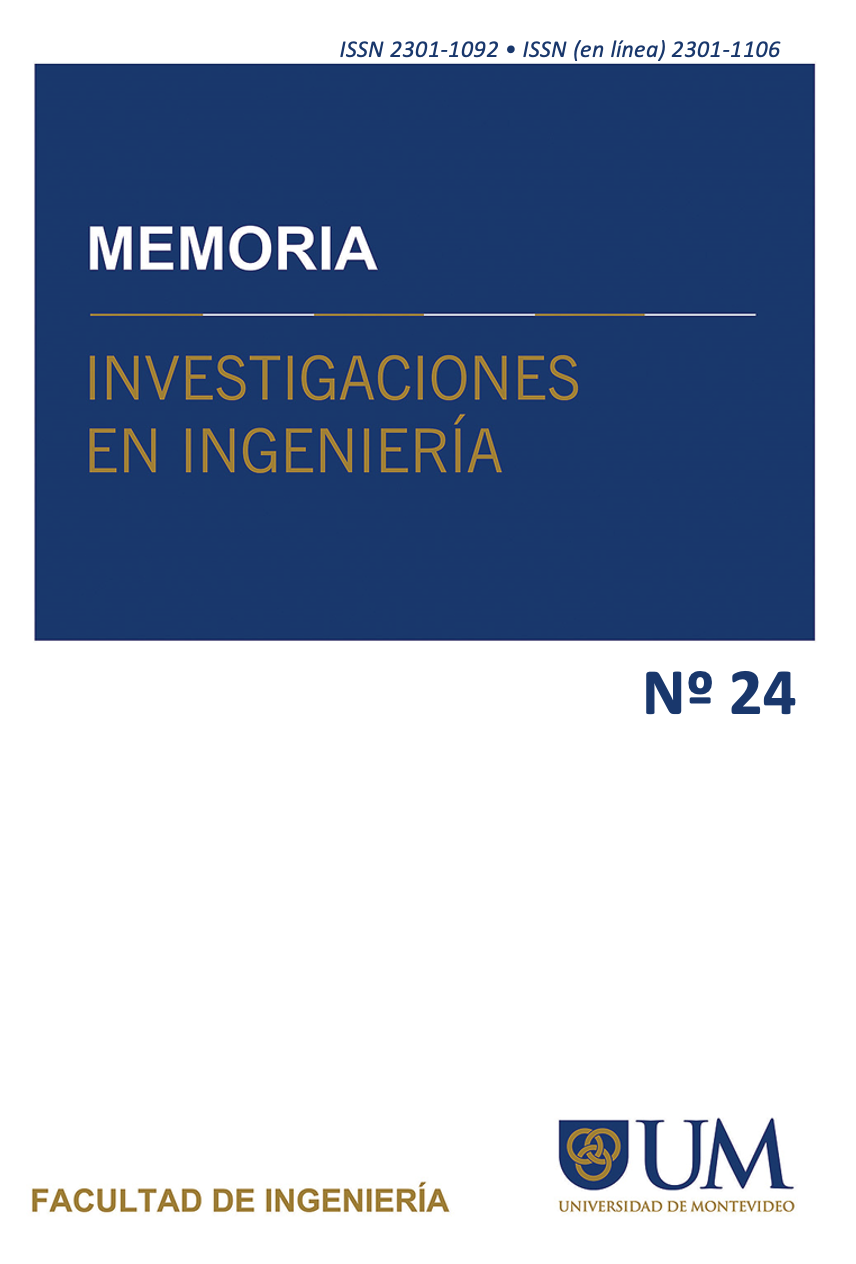Modelado de materiales y estudio de fallas de diferentes compuestos reforzados con fibra para recipientes a presión
DOI:
https://doi.org/10.36561/ING.24.7Palabras clave:
Recipientes a presión, Compuestos Reforzados, Compuestos de Fibra, ModeladoResumen
Los recipientes a presión son herramientas industriales esenciales para el almacenamiento de fluidos a alta presión. La utilización de recipientes a presión en el entorno industrial ordinario impone serios peligros para la vida humana en caso de falla. El material de fabricación y la presión de trabajo según la resistencia del material son argumentos necesarios para un diseñador de recipientes a presión. En este estudio, se seleccionan cinco materiales compuestos para investigar el comportamiento de los recipientes a presión bajo alta presión. La técnica FEA se utiliza para comprobar tensiones y deformaciones en diferentes capas compuestas. La presión aplicada a todos los modelos de materiales en este estudio es de alrededor de 20 MPa. Las teorías de Tsai Wu y la tensión máxima se utilizan para estudiar la falla en las dos primeras capas compuestas de diferentes materiales compuestos. Los compuestos de epoxi de vidrio funcionan bien en términos de falla de carga estática. Demuestran una fuerza razonable sin experimentar fallas en la segunda capa. Los compuestos T300/976 también son adecuados para las condiciones de carga previstas del modelo porque no presentaron fallas en la segunda capa, lo que los convierte en una opción viable. Por lo tanto, se recomienda utilizar compuestos de vidrio/epoxi y T300/976 en condiciones de presión extrema, como las que se encuentran en los cilindros de GNC. Tres de los materiales compuestos probados no cumplieron con las teorías de falla. Por lo tanto, no es seguro usarlos en condiciones de carga extremas. Si bien estos materiales no presentaron falla alguna en la primera capa, las deformaciones en la segunda capa los hicieron susceptibles a la falla.
Descargas
Citas
Muhammad Azeem, Hamdan Haji Ya, “Application of Filament Winding Technology in
Composite Pressure Vessels and Challenges: A Review” Journal of Energy Storage, Volume 49
May 2022.
Afthab Afrathim, Saravanan Karuppanan, Santosh S. Patil, “Burst strength analysis of thin
composite pressure vessels” Materials Today: Proceedings (44) [2021] 3115-3120.
E.S. Barboza Neto a, “Experimental and numerical analysis of a lldpe/hdpe liner for a
composite pressure vessel,” Polymer Testing, p. 693–700, 2011.
J. P.Xu, “Finite element analysis of burst pressure of composite hydrogen storage vessels,”
Materials and design, pp. 2295-2301, 2009.
A. Gaurav Singh Chauhan, “Design and analysis of high-pressure composite vessels,”
International Journal of Latest Engineering and Management Research (IJLEMR), pp. 96-102,
June 2018
Shah Alam, Gregory Yandek, Richard Chris Lee, Joseph Mabry, “A study of residual burst
strength of composite over wrapped pressure vessel due to low velocity impact” International
journal of Pressure Vessel and Piping 194 (2021) 104511
Marino Quaresimin, Mauro Ricotta, Livio Martello, Stefano Mian, “Energy absorption in
composite laminates under impact loading” Composite: Part B 44 (2013) 133-140.
D.J Chang “Burst Tests of Filament-wound Graphite-epoxy Tubes” SAGE Journal of
Composite Material, May 2003.
S. Takalkar Atul S “Finite element analysis of composite overwrapped pressure vessel for
hydrogen storage,” in 2016 Intl. Conference on Advances in Computing, Communications, and
Informatics (ICACCI), Jaipur, India, Sept. 21-24, 2016.
Goat Giancarlo, Langella Antonio , Lopresto Valentina, “ Prediction of the first failure energy
of circular carbon fiber reinforced plastic plates loaded at the center” Composites. Part A: Applied
Science and Manufacturing, 34 (2003)
V.V.Vasiliev , A.A.Krikanov ,A.F.Razin “ New generation of filament-wound composite
pressure vessels for commercial applications” Composite Structures, Volume 62 Issues 3-4, 2003.
M. Z. Kabir, “Finite element analysis of composite pressure vessel with load sharing metalic
liner,” Composite Structures 49, pp. 247-255, 2000.
Yongzheng Shao, “High pressure strength of carbon fibre reinforced vinylester and epoxy
vessels” Composite Structures, December 20.
J.C. Choi, S.Y. Jung, C. Kim, Development of an automated design system of a CNG
composite vessel using a steel liner manufactured using the DDI process, Int. J. Adv. Manuf.
Technol. 24 (2004) 781–788, https://doi.org/10.1007/s00170-003-1798-4.
¨O.S. Sahin, A. Akdemir, A. Avci, L. Gemi, Fatigue Crack Growth Behavior of Filament
Wound Composite Pipes in Corrosive Environment, J. Reinf. Plast. Compos. 28 (2009) 2957–
, https://doi.org/10.1177/0731684408094068.
C. Red, The outlook for composite pressure vessels, Compos. Technol. 15 (2009).
https://www.compositesworld.com/articles/the-outlook-for-composite-pressure-vessels.
[Accessed October 24, 2021].
Opportunities for Composite CNG Tanks in Global Automotive Industry, Lucintel. Com
(2020). https://www.lucintel.com/composite-cng-tanks-in-automotive-2020.aspx. [Accessed July
, 2021]
B.G. Sumana, H.N.V. Sagar, M. Krishna, G.R. Rajkumar, Investigation of Burst Pressure on
Carbon /Glass Fiber Reinforced Polymer Metal Tube for High Pressure Applications, Procedia
Mater. Sci. 5 (2014) 535–539, https://doi.org/10.1016/j.mspro.2014.07.297.
Atif Shazad, Junaid Jadoon, Muhammad Uzair, Maaz Akhtar, Abdul Shakoor, Muhammad
Muzamil, and Mohsin Sattar (2022) Effect of composition and microstructure on the rusting of MS
rebars and ultimately their impact on mechanical behavior. Transactions of the Canadian Society
for Mechanical Engineering. 46(4): 685-696. https://doi.org/10.1139/tcsme-2021-0207
Publicado
Cómo citar
Número
Sección
Licencia
Derechos de autor 2023 Atif Shazad, Junaid Jadoon, Muhammad Uzair, Muhammad Muzammil

Esta obra está bajo una licencia internacional Creative Commons Atribución 4.0.






















